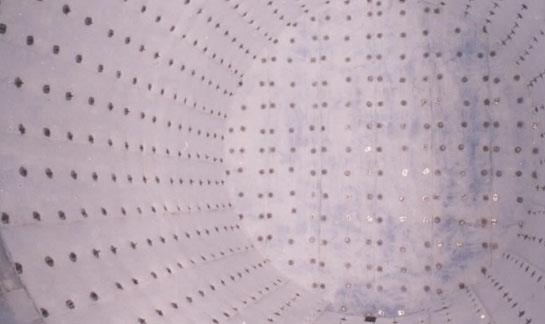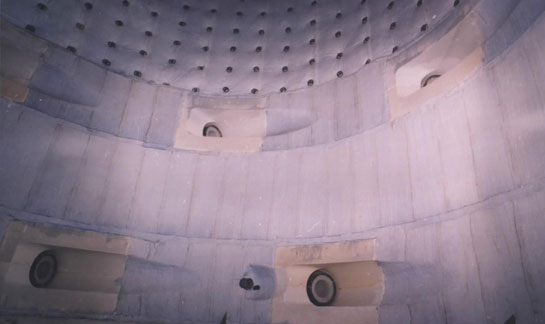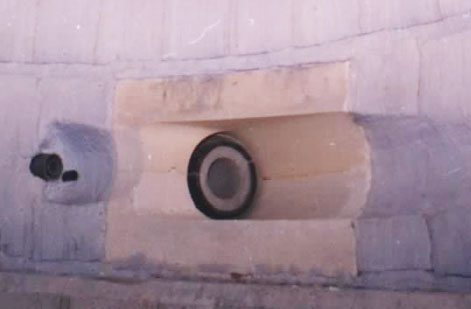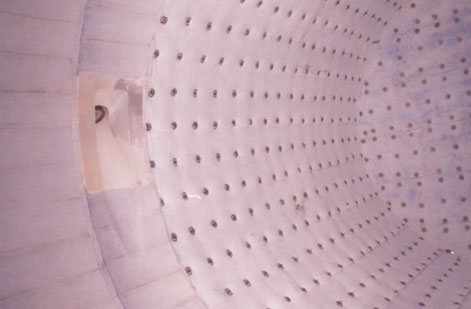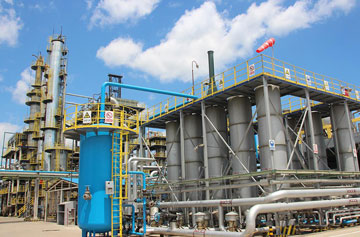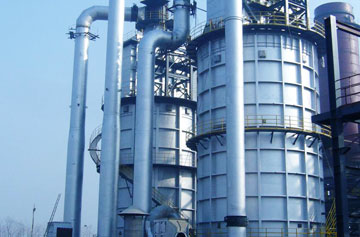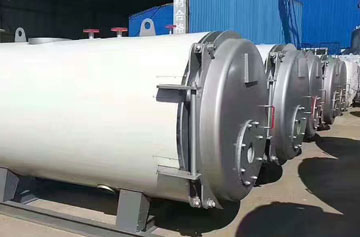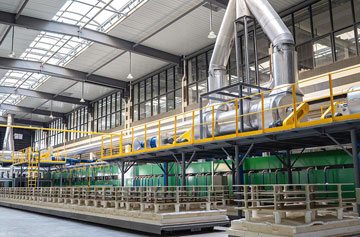Design and construction of the heating lining of bell-type furnaces
Overview:
Bell-type furnaces are mainly used for bright annealing and heat treatment, so they are intermittent varied-temperature furnaces. The temperature stays between 650 and 1100 ℃ mostly, and it changes by the time specified in the heating system. Based on the loading of bell-type furnaces, there are two types: the square bell-type furnace and the round bell-type furnace. The heat sources of bell-type furnaces are mostly gas, followed by electricity and light oil. Generally, bell-type furnaces consist of three parts: an outer cover, an inner cover, and a stove. The combustion device is usually set on the outer cover insulated with a thermal layer, while workpieces are placed in the inner cover for heating and cooling.
Bell-type furnaces have good air tightness, low heat loss, and high thermal efficiency. Moreover, they need neither a furnace door nor a lifting mechanism and other various mechanical transmission mechanisms, so they save costs and are widely used in the heat treatment furnaces of workpieces.
Two most critical requirements for furnace lining materials are light weight and energy efficiency of the heating covers.
Common problems with traditional lightweight refractory bricks or lightweight castable structures include:
1. Refractory materials with a large specific gravity (generally regular lightweight refractory bricks have a specific gravity of 600KG/m3 or more; lightweight castable has 1000 KG/m3 or more) require a large load on the steel structure of the furnace cover, so both the consumption of the steel structure and the investment in furnace construction increase.
2. The bulky outer cover affects the lifting capacity and the floor space of the production workshops.
3. The bell-type furnace is operated at intermittent varied temperatures, and light refractory bricks or light castable have a large specific heat capacity, a high thermal conductivity, and a huge energy consumption.
However, CCEWOOL refractory fiber products have a low thermal conductivity, low heat storage, and low volume density, which are the key reasons for their wide applications in heating covers. The characteristics are as follows:
1. A wide operational temperature range and various application forms
With the development of CCEWOOL ceramic fiber production and technology, CCEWOOL ceramic fiber products have achieved serialization and functionalization. In terms of temperature, the products can meet the requirements of different temperatures ranging from 600 ℃ to 1500℃. In terms of morphology, the products have gradually developed a variety of secondary processing or deep processing products from traditional cotton, blankets, felt products to fiber modules, boards, special-shaped parts, paper, fiber textiles and so on. They can fully meet the requirements of industrial furnaces for ceramic fiber products in various industries.
2. Small volume density:
The volume density of ceramic fiber products is generally 96~160kg/m3, which is about 1/3 of lightweight bricks and 1/5 of the lightweight refractory castable. For the newly designed furnace, the use of ceramic fiber products can not only save steel, but also make loading/unloading and transportation more easily, propelling the progress in the industrial furnace technology.
3. Small heat capacity and heat storage:
Compared with refractory bricks and insulation bricks, the capacity of ceramic fiber products is much lower, about 1/14-1/13 of refractory bricks and 1/7-1/6 of insulation bricks. For the intermittently operated bell-type furnace, a large amount of non-production-related fuel consumption can be saved.
4. Simple construction, short period
As ceramic fiber blankets and modules have excellent elasticity, the amount of compression can be predicted, and there is no need to leave expansion joints during construction. As a result, the construction is easy and simple, which can be completed by regular skilled workers.
5. Operation without an oven
By adopting the full-fiber lining, furnaces can quickly be heated to the process temperature if not restricted by other metal components, which greatly improves the effective utilization of industrial furnaces and reduces non-production-related fuel consumption.
6. Very low thermal conductivity
Ceramic fiber is a combination of fibers with a diameter of 3-5um, so it has very low thermal conductivity. For example, when a high-aluminum fiber blanket with a density of 128kg/m3 reaches 1000℃ at hot surface, its heat transfer coefficient is only 0.22(W/M.K).
7. Good chemical stability and resistance to airflow erosion:
Ceramic fiber can only be eroded in phosphoric acid, hydrofluoric acid, and hot alkali, and it is stable to other corrosive media. In addition, the ceramic fiber modules are made by continuously folding ceramic fiber blankets at a certain compression ratio. After the surface is treated, the wind erosion resistance can reach 30m/s.
The application structure of ceramic fiber
The common lining structure of the heating cover
The burner area of the heating cover: It adopts a composite structure of CCEWOOL ceramic fiber modules and layered ceramic fiber carpets. The material of the back lining blankets can be one grade lower than the material of the layer module material of the hot surface. The modules are arranged in “a battalion of soldiers” type and fixed with angle iron or suspended modules.
The angle iron module is the easiest way for installation and use as it has a simple anchoring structure and can protect the flatness of the furnace lining to the greatest extent.
Above-the-burner areas
A layering method of CCEWOOL ceramic fiber blankets is adopted. Layered furnace lining generally requires 6 to 9 layers, fixed by heat-resistant steel screws, screws, quick cards, rotating cards, and other fixing parts. High-temp ceramic fiber blankets are used about 150 mm close to the hot surface, while the other parts use low-grade ceramic fiber blankets. When laying blankets, the joints should be at least 100 mm apart. The inner ceramic fiber blankets are butt-joined to facilitate construction, and the layers on the hot surface take the overlapping method to ensure the sealing effects.
The application effects of ceramic fiber lining
The effects of the full-fiber structure of the bell-type furnaces’ heating cover have remained very good. The outer cover that adopts this structure not only guarantees the excellent insulation, but also enables easy construction; therefore, it is a new structure with great promotional values for cylindrical heating furnaces.
Post time: Apr-30-2021


